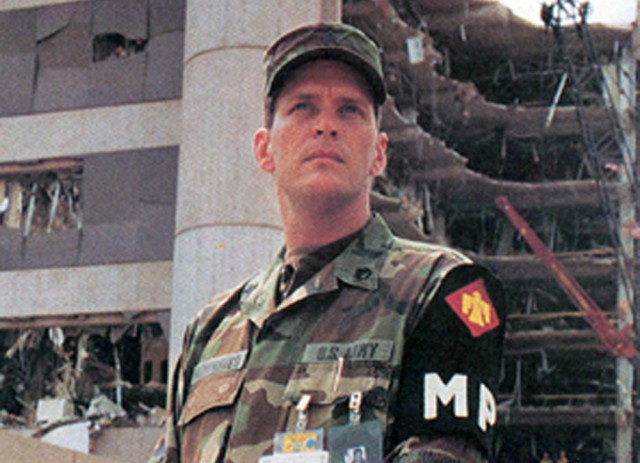ARLINGTON, Va. (April 19, 2010) -- Some describe April 19 as "the day the world began to look at terrorism differently."
Hundreds of Oklahoma National Guard members will remember today's date by how they responded 15 years ago to a homeland disaster, unexpectedly, and on a scale never before seen.
At 9:02 a.m. (CST), April 19, 1995, the Alfred P. Murrah Federal Building in Oklahoma City was the target of a bombing called "the most significant act of domestic terrorism on American soil."
A rental truck filled with explosives parked in front of the building exploded, destroying the north side of the building and killing 168, including 19 children. At least 850 more were injured.
Today, Oklahomans, federal officials, domestic responders, family members, Guardmembers and others will gather at the grounds of the Oklahoma City National Memorial and Museum to remember as they have each year since the tragedy.
"There were just a lot of people affected by the tragedy, affected even today," said Army Maj. Gen. Myles L. Deering, the adjutant general of Oklahoma, in a recent telephone interview.
"If you go to one of the ceremonies, you still get a knot in your throat," he said. "It is still heavy on their minds to what happened that day. You take the people who were tragically killed ... and look at the chain or the string that each of those people has with other people's lives, it's just amazing how many people, either directly or indirectly, knew somebody who suffered a fate during that day."
On that morning, and almost immediately, the Oklahoma Guard responded to requests for military assistance. From then on, it was involved in every phase of the operation, Guard officials said.
At least 731 Oklahoma Guard members, including 624 Citizen-Soldiers and 107 Citizen-Airmen, assisted civilian and government response agencies in the hours and days following the bombing.
"In a sense, that was the Guard's first exposure to a terrorist event," said Deering. "It woke us in terms of our response [which] has to be in coordination and in concert with those civilian authorities who are in charge of the event that we are in support of, and how we can augment, how we can bring resources to the table to assist them in their jobs."
At the time, Deering was working as the executive officer for the Oklahoma Guard's 45th Infantry Brigade and as its full-time officer-in-charge.
"I was in a meeting in my office with another Soldier ... the plate glass window right behind me nearly came out of its seams," he said.
He was 12 miles away.
Army Brig. Gen. Robbie L. Asher, Oklahoma's director of the Joint Staff, said he took the initial call for Guard assistance when a firefighter called their Command Group at the Oklahoma Guard headquarters, pleading for help.
"He was very excited, saying, 'Sir, we need help, we need help down here,'" said Asher.
Newly elected Gov. Frank Keating quickly activated the Guard to support the incident commander: Oklahoma City Fire Chief, Gary Marrs.
At the scene, some 100 Guardmembers immediately helped the search for survivors. They set up an emergency operations center and reported to the state's civil emergency management agency.
Army aviators and medical personnel stood ready with lifesaving care and medevac. Others assisted police with site security and cleared debris from the scene.
Asher said he has a better appreciation today for how the Guard supported emergency responders from the multiple agencies across the state and the nation who worked the mission.
In the recovery operations, Guardmembers helped maintain the security perimeter, brought in equipment and airlifted supplies and donations.
Still other Guardmembers helped the state medical examiner transport and identify the dead. Casualty notification officers contacted next-of-kin, and Guard chaplains assisted families.
In the criminal investigation, Airmen flew reconnaissance missions to photograph the disaster site, and Soldiers even transported the arrested bombing suspect on a military helicopter.
East of the city, Soldiers crawled on their hands and knees to help the FBI comb through more than 120 dump-truck loads of debris for evidence and additional human remains.
"That was one of the more challenging jobs that I think any of our Soldiers had to do," said Asher.
Those not on duty volunteered long days with the American Red Cross and the Salvation Army. They did anything asked of them, officials said at the time.
Asher said it's important to remind the nation about what happened. The Oklahoma Guard uses what it learned about multi-agency response in its current operations, including last winter's joint ice storm response, he said.
"The state of Oklahoma came together with the nation's support and grew from this," said Asher. "It showed the world that we are resilient, and when you deal with Americans, we are going to come together."
For Asher and other Oklahoma Guardsmen, their capital city serves as their vigilant reminder.
"When you drive down through Oklahoma City, and you see the memorial, it's one of those things that always cause reflection," said Asher.


Social Sharing